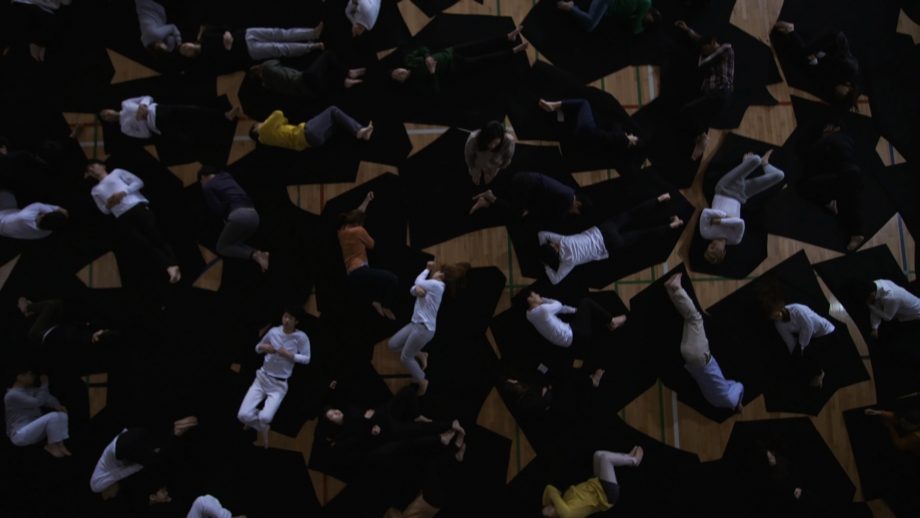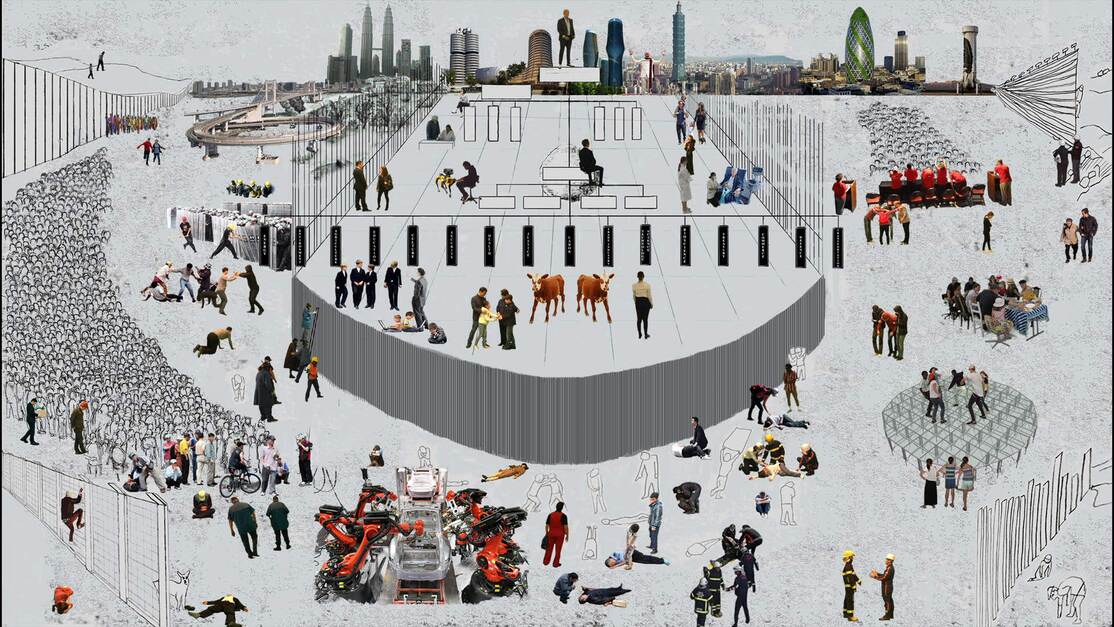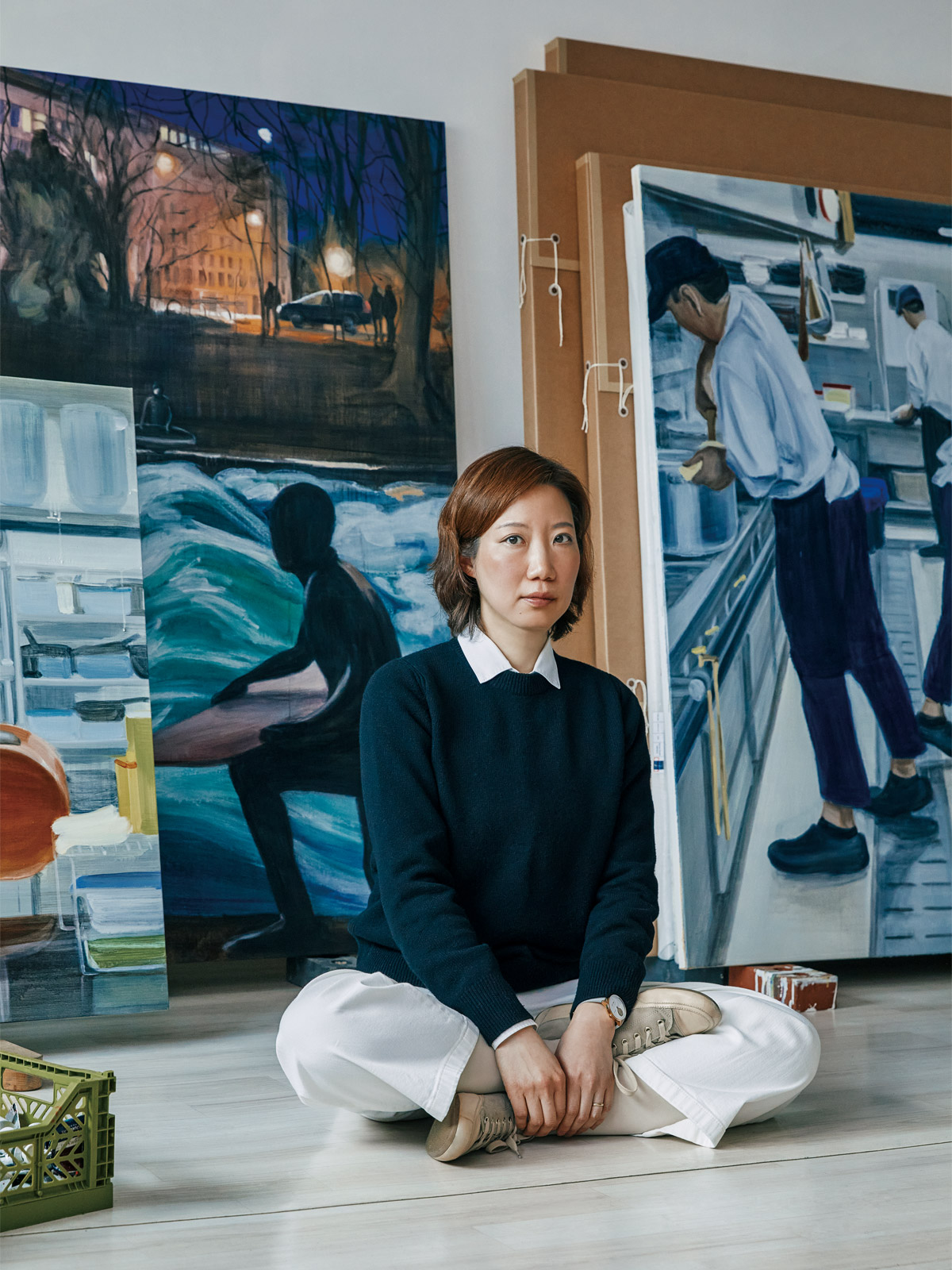Yang Ah Ham (b. 1968) has been working
on themes related to individuals and groups within societal systems and the
socialized nature, drawing from her experiences living in various regions such
as Korea, the Netherlands, and Turkey. Based on these themes, she has presented
experimental installations using a variety of media, including video,
sculpture, installation, and objects.
As a media artist, Ham starts from
individual experiences, embedding unique narratives in her works that
metaphorically depict slices of society.
 Yang Ah Ham, Cheese,
1996-1997 ©Yang Ah Ham
Yang Ah Ham, Cheese,
1996-1997 ©Yang Ah HamAfter moving to New York to study
video art, she began exploring the existential condition of microscopic beings
through video. For example, her video work Cheese
(1996-1997) captured the process of cheese decaying, metaphorically expressing
the cycle of life and death.
By dealing with themes of life and
death, the element of "time" inevitably becomes a crucial aspect of
her work. In Sensuous Space (1998), for instance, the
artist documents the entire process of planting, growing, and eventually
withering bean sprouts. Ham’s work often begins with observing the passage of
time and the progression of life, capturing existential moments in the process
through meticulous, frame-by-frame production.
 Yang Ah Ham, fiCtionaRy,
2002-2003 ©MMCA
Yang Ah Ham, fiCtionaRy,
2002-2003 ©MMCAYang Ah Ham’s early video works were
focused on the transformation of matter over time, and on sensory and tactile
imagery. However, starting with fiCtionaRy (2002-2003),
her work shifted from "temporality" and "sensation" to
"narrative." At this point, she also began creating works about
subjects moving outside the studio.
fiCtionaRy
was produced while she worked as an art director for an independent film,
documenting the filmmaking process daily. In the video, two worlds coexist: the
fictional world of the film being shot and the real world of the crew
struggling to bring it to life. These two worlds alternate through split scenes
and cross-editing before finally appearing in a single frame. As the title
"fictionary" suggests, the work is a kind of documentary fiction,
blending the fictional world with the real one that encompasses it.

Yang Ah Ham, Land, Home, City, 2006 ©Busan Biennale
After 2005, Yang Ah Ham underwent
another transformation in her creative approach. Until then, her process
involved shooting and editing in a documentary style, determining how to
narrate the subject during this process. Through this method, she formed a
relationship with the subject, which led her to ponder the ethical
responsibility of how to portray people in her works.
The video Land,
Home, City (2006),
based on these reflections, centers around a fictional narrative created by the
artist. It depicts different aspects of nomadic lives, drawing from her own
experiences traveling the world through various residency programs. Among the
fictional characters in the work, one is a real person, blurring the lines
between fact and fiction.
Land, Home, City
highlights how personal identity in the age of globalization is not fixed by
one's birthplace or language, but rather constantly evolves through new
experiences shaped by movement.
 Yang
Ah Ham, Chocolate
Head, 2007
©Art Sonje Center
Yang
Ah Ham, Chocolate
Head, 2007
©Art Sonje CenterFollowing this, Ham began addressing
ideologies and societal systems embedded in society through her art. Her first
exploration of this theme was through examining power structures within the art
world. A notable example is Out of Frame (2007), where performers freely
engage with Chocolate Head (2007) modeled after
world-renowned curators.
The artist believes that power is
shaped by the surrounding environment. Out of Frame captures
the process of power formation in a performance video, where the performers
autonomously engage with chocolate head without the artist’s direction.
 Yang Ah Ham, Out
of Frame, 2007 ©Yang Ah Ham
Yang Ah Ham, Out
of Frame, 2007 ©Yang Ah HamAs the performers continue the work, a sense of competition begins to emerge. Some take bold actions, while others retreat. Initially, they lick or caress the chocolate head, but as the performance progresses, their behavior becomes more aggressive, eventually leading to the destruction of the head. The artist reverses this sequence in editing, making it appear as though the performers are in the process of constructing power, rather than dismantling it.
 Installation view
of “Yang Ah Ham: Adjective Life in the Nonsense Factory” in 2010 ©Art Sonje
Center
Installation view
of “Yang Ah Ham: Adjective Life in the Nonsense Factory” in 2010 ©Art Sonje
CenterIn her 2010 solo exhibition at the Art Sonje Center, “Yang Ah Ham: Adjective Life in the Nonsense Factory,” the artist unveiled Nonsense Factory (2010), which tells the story of individuals within a fictional society. The imaginary "factory" in the piece pursues creativity and productivity, yet reveals absurd realities, with its inhabitants repeatedly facing alienation despite their efforts.
 Yang Ah Ham, The
Sleep, 2015 ©SeMA Seoul Mediacity Biennale
Yang Ah Ham, The
Sleep, 2015 ©SeMA Seoul Mediacity BiennaleThe artist’s fiction is not detached from reality but is instead grounded in real-world narratives. Nonsense Factory metaphorically portrays the lives of individuals navigating the relentless demands of societal systems through a fictional society. Also, The Sleep (2015), set against the backdrop of the Sewol Ferry disaster, symbolically captures the fear and anxiety experienced by individuals within societal systems and regulations designed to control and protect them, using fiction as a metaphorical lens.
 Yang Ah Ham, Undefined
Panorama 2.0, 2019 ©Ilmin Museum of Art
Yang Ah Ham, Undefined
Panorama 2.0, 2019 ©Ilmin Museum of ArtFrom 2014 onwards, the artist began
contemplating her role as an artist within society, naturally extending her
concerns beyond the personal to the social, leading her to create works that
pose direct questions about political systems.
Her photo montage work Undefined
Panorama 2.0 (2019) presents a genre painting of contemporary
mankind. Initially sketched in 2018, it features a background of
two-dimensional organizational charts of modern political systems and the
insurmountable barriers they create. Ham drew both the individuals within and
outside the charts in pencil, layering over them video depictions of their
actions.
Yang Ah Ham’s work presents a kind of
puppet show where each figure performs their role on the stage, representing
the current social system. She describes these figures as existing not as mere
"composition" on a flat surface but in terms of
"construction" within a framework of reality, borrowing from the
Russian constructivist concept. Rather than aesthetically composing images,
"construction" refers to abstracting the reality of the real world
into imagery.
 Installation view
of “Yang Ah Ham_Undefined Panorama 2.0” in 2019 ©Ilmin Museum of Art
Installation view
of “Yang Ah Ham_Undefined Panorama 2.0” in 2019 ©Ilmin Museum of ArtThus, Yang Ah Ham reconstructs elements drawn from the original context of reality, placing them on new stages, continuously posing questions about society by abstracting the reality of individuals' lives in the present, navigating between documentary and fiction.
"When I look at a subject, I try
to mobilize everything I have to grasp it—instinct, reason, intuition,
everything. My perception of the subject and the conclusions I reach after
reflecting on it, that is what I call reality.
The process of bringing the reality in
my mind back into the real world and reconstructing it in real space—that’s
what I believe is the creative process of producing an artwork." (MMCA Artist Talk | Yang
Ah Ham)

함양아 작가 ©더 아트로. 사진: 박홍순
Yang Ah Ham received her BFA degrees
in painting and also received masters in art theory at Seoul National
University. She also studied media art at the graduate school of New York
University.
Ham has been exhibited in many solo
and group shows including “Trans – Justice” (Taipei MOCA 2018), Asia Art
Biennale (Taiwan national museum of fine arts, 2017), Media City Seoul Biennale
(SeMA, 2016), “Discordant Harmony” (Art Sonje Center, Hiroshima MOCA, Taipei
Kuandu Museum, 2015-16), Korea Artist Prize 2013 (MMCA, 2013).
She was awarded the Art of the year
prize, (Art council of Korea, 2005). Ham participated in Rijksakademie
residency in Amsterdam in 2006-2007.
References
- 올해의 작가상, 함양아 (Korea Artist Prize, Yang Ah Ham)
- 국립현대미술관, 함양아 | 픽셔너리 | 2002 – 2003 (National Museum of Modern and Contemporary Art Korea (MMCA), Yang Ah Ham | fiCtionaRy | 2002-2003)
- 일민미술관, 함양아_정의되지 않은 파노라마 2.0 (Ilmin Museum of Art, Yang Ah Ham_Undefined Panorama 2.0)
- 2006 부산비엔날레, 함양아 – 땅, 집, 도시 (2006 Busan Biennale, Yang Ah Ham – Land, Home, City)
- 아트선재센터, 함양아: 형용사적 삶 – 넌센스 팩토리 (Art Sonje Center, Yang Ah Ham: Adjective Life in the Nonsense Factory)




















